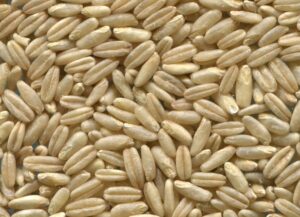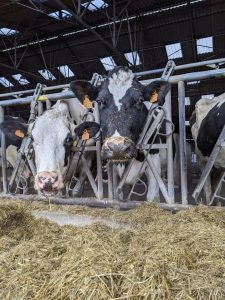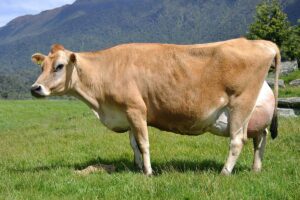Fernando Diaz
Corn (Zea mays L.) is nowadays the main cereal grain included in dairy cow diets in the US. Nonetheless, the cold weather of the west of Canada and some of the European countries is not adequate for cultivating corn, being wheat (Triticum aestivum L.), the main cereal grain produced in those areas.
When compared with corn, wheat is higher in protein content and lower in starch. Additionally, its starch is more quickly degradable in the rumen than corn starch. Therefore, lactating dairy cows consuming diets with a high proportion of wheat are prone to low ruminal pH and may be affected with subclinical and clinical acidosis.
A recent experiment published in Animal Production Science examined the effects of including either wheat or corn grain in the diets. The study, conducted at the Department of Economic Development, Jobs, Transport and Resources, Ellinbank Centre, Victoria, Australia mimicked the feeding program followed by most of Australian dairy farms in which concentrate is fed to cows during milking.
Cows were milked twice at 06:15 am and 03:15 pm and fed individually during 2 feeding periods, one in the morning (06:30 – 11:00) and one in the afternoon (15:30 – 20:00). The diet included 10.2 kg dry matter (DM) of alfalfa hay and 12.2 kg DM of concentrate. The concentrate was composed of 1.0% minerals, 1.0% molasses, 16.4% cold-pressed canola and 81.6% of either rolled wheat or rolled corn on a DM basis, and was offered to cows during the first 30 minutes of each feeding period. The alfalfa hay was offered during the remainder of the feeding period. As expected, rolled wheat contained more protein (13.6 vs. 9.7% DM) but less starch (56.6 vs. 63.1% DM) and fat (1.8 vs. 4.45 DM) than rolled corn (table). Non-fibrous carbohydrate concentration; however, was similar in both cereal grains (~73.0% DM).
| Nutrient |
Rolled Wheat |
Rolled Corn |
| Dry Matter (DM) % |
93.5 |
91.3 |
| Crude Protein (% DM) |
13.6 |
9.7 |
| NDF (% DM) |
13.8 |
11.6 |
| ADF (% DM) |
6.6 |
4.4 |
| Lignin (% DM) |
1.1 |
1.0 |
| Starch (% DM) |
56.6 |
63.1 |
| NFC (% DM) |
72.7 |
73.2 |
| Calcium (% DM) |
0.08 |
0.01 |
| Phosphorous (% DM) |
0.34 |
0.37 |
| Magnesium (% DM) |
0.16 |
0.17 |
| Sulfur (% DM) |
0.16 |
0.11 |
Feeding wheat affected negatively cow intake and performance. Cows receiving the wheat-based concentrated consumed less hay (9.1 vs. 10.1 kg/day) and produced less energy-corrected-milk (23.8 vs. 28.6 kg/day) than cows offered the corn-based concentrate. Additionally, milk fat content was severely lower (2.75 vs. 4.23%) and milk protein was slightly greater (3.38 vs. 3.25) in cows fed the wheat diet.
Moreover, there were differences is ruminal pH between diets. Using intra-ruminal bolus in fistulated cows, the authors (Moate et al., 2019) measured pH continuously over two days in ruminal fluid. Average ruminal pH was similar between diets (6.18); however, the duration that ruminal pH was below 6 in cows fed the wheat diet was nearly twice (633 minutes) that in cows fed the corn diet (334 minutes).
In conclusion, replacing rolled corn with rolled wheat in diets with high level of cereal grains (45% DM) is not recommended. Wheat starch is rapidly degraded in the rumen and reduces ruminal pH and milk fat yield. In feeding programs where forages and concentrates are fed separately and/or cows have limited access to feeds, using rolled corn instead of wheat as the main energy source is preferred.
Reference
P. J. Moate, S. R. O. Williams, M. H. Deighton, M. C. Hannah, B. E. Ribaux, G. L. Morris, J. L. Jacobs, J. Hill, and W. J. Wales. 2019. Effects of feeding wheat or corn and of rumen fistulation on milk production and methane emissions of dairy cows. Animal Production Science. 59: 891-905.









